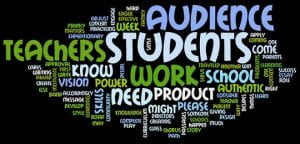My journey in education has only just begun, and the more pedagogical exploration I have, the more invigorated I feel for that future to come. I see the classroom as a challenge for both the students and the teacher. For the students, challenge helps them learn, grow, and take risks. For a teacher, it does the same with the added benefit of fine-tuning instruction for a variety of learners and requirements.
When it comes to teaching, there is no “one way,” “right answer” approach. Every day is an experiment in lesson planning and progression based on adaption to student learning.
The only requirement I think teaching really has is not giving up.
 Not for those students, and not for me. There will always be a way to shift perspectives, make changes and modifications so that every student has an avenue of success. And my challenge is to make sure the students know that those avenues exist and help them get there.
Not for those students, and not for me. There will always be a way to shift perspectives, make changes and modifications so that every student has an avenue of success. And my challenge is to make sure the students know that those avenues exist and help them get there.
Reading through Gee’s “Good Video Games and Good Learning,” I found myself enamored with the parallels he drew between gaming and learning through the learning principles we most seek to foster in our students. The one that impacted me the most was Risk-Taking. Too often in the classroom, students (and teachers) struggle with the insecurities of not being good enough in a particular subject, at a specific task, and give up before they try something new or to meet a challenge. I find that teachers are more willing to complacently stick to the traditional lesson plans and curriculum guides than to try something new, like Podcasting or Gamification. However, being able to take risks and learn with your students can help give them the confidence they need to take a risk themselves.
If we are all willing to jump headfirst into that next Boss Battle without even considering leveling up first and learn as we go, why are we so hesitant to do that in the classroom? We rage over video games and eagerly – almost obsessively – try and retry to succeed where we have failed. I think we desperately need to try to incorporate a similar mentality of gaming into our classrooms.
I definitely don’t mean to teach our students to explode when they can’t conquer a five-paragraph essay, but to continue searching through “patterns” and “feedback” for that ultimate combo finisher.
This is where I think ideas from Klein and Yancey about ePortfolios can make a dramatic change in our approach to education.
Just like relating the classroom experience to video games, we want to make learning relevant and meaningful for students. Some teachers can do this through gamification. I’ve read an article about a teacher who created and integrated an entire gamified classroom system based on Mario and had students play this “game” throughout the year (If I can find it, I will attach it here!). However, this can be incredibly daunting, albeit fun and rewarding in the payoff.
For other teachers, I think the ePortfolio system is an incredible way to enhance learning and make it relevant, meaningful, and sustainable. So many times in my own student career, I was faced with creating physical, paper and binder, portfolios. Sure, I was given the awesome option of making them scrapbooks with themes, and I really got into it – but that was me. I was the creative nerd who LOVED things like that, but students now are getting farther and farther away from this and closer and closer to the digital world and its vast media.
The inclusion of an ePortfolio system in the English classroom awards a substantial spectrum of media and accessibility. Students are able to make their portfolio anything they want it to be, whether that’s journal-based, vlogging, Podcasting, visual showcasing. There are so many styles and affordances of ePortfolios that enable students to include diverse media in their regular writing.
That struck me most about the ePortfolios was Yancey’s description of them as being a part of a “reiterative process.” When I think about the capacities of employing an ePortfolio is my classroom, I become giddy. The options are endless and, more than that, fun.
In my own classroom, I would love for students to compile an ePortfolio, year long. At the beginning of the year, I would help them navigate the medium and its affordances, showing examples where necessary. However, once the first assignment is done, we won’t just abandon the portfolio, but we’ll continue it and add to it throughout the year.
 There’s a platform I love for its educational possibilities, SocialDummy, and students have so much fun with it. It is an app that allows users to create un-postable profiles and posts for all different social media platforms. For an English classroom, I think this would allow students to do such wonderful close readings of characters in a medium they understand all too well. What would Romeo’s twitter update look like? Or Holden’s Spotify playlist?
There’s a platform I love for its educational possibilities, SocialDummy, and students have so much fun with it. It is an app that allows users to create un-postable profiles and posts for all different social media platforms. For an English classroom, I think this would allow students to do such wonderful close readings of characters in a medium they understand all too well. What would Romeo’s twitter update look like? Or Holden’s Spotify playlist?
Technology in the classroom allows us to not only analyze content but make it relevant to our time and situations. I think combining an ePortfolio system with these applications of apps like SocialDummy, a platform can be made that builds in the learning objectives outlined by all of these authors.
There are so many possibilities for educational applications of media, and I think that they are all more sustainable and meaningful than the traditional approaches that have been ingrained in school curricula for decades. The wonderful thing about these technological approaches is that they all afford avenues of enhancing and enriching the student experience as they learn and reflect. In addition, they really challenge teaching practices because they force teachers to practice what they preach: to take risks, go outside the mold of traditional teaching, and challenge their own thinking and teaching practices.




This was a fun read!
The risk-taking discussion resonates with me. It’s too easy to do the same thing over and over again. To be good teachers, we cannot be static, and with the world of technology ever expanding, we need to expand with it. I very much appreciate the specific apps you referenced; it can become time consuming and even intimidating to continually “keep up” with the expansion; when communities of educators can share an idea or collaborate even more deeply on something, all the better for everyone.
You mention that you are early in your teaching career–I’m really happy to see how much enthusiasm you have!
I am going to echo what Allison Bressmer said and say thanks for some of the recommendations and references to different resources. I too have a hard time and struggle to keep up with new platforms and enjoy hearing what other people are using or noticing. I just found out about TikTok several months ago from a student in an undergrad lecture!
I also wanted to affirm some of your proposed benefits to utilizing technology like “SocialDummy” as a resource that can bolden and enhance approaches toward understanding things like character or personality in the stories we read. I even believe that this can continue at the university level. I remember taking a class on James Joyce’s Ulysses and when the book began to bog down even the most fascinated readers, the professor encouraged us to do some of the very things you mentioned. Some students crafted playlist, others developed animated models of the story’s world, and a few found ways to use technology to narrow their experience for the better.